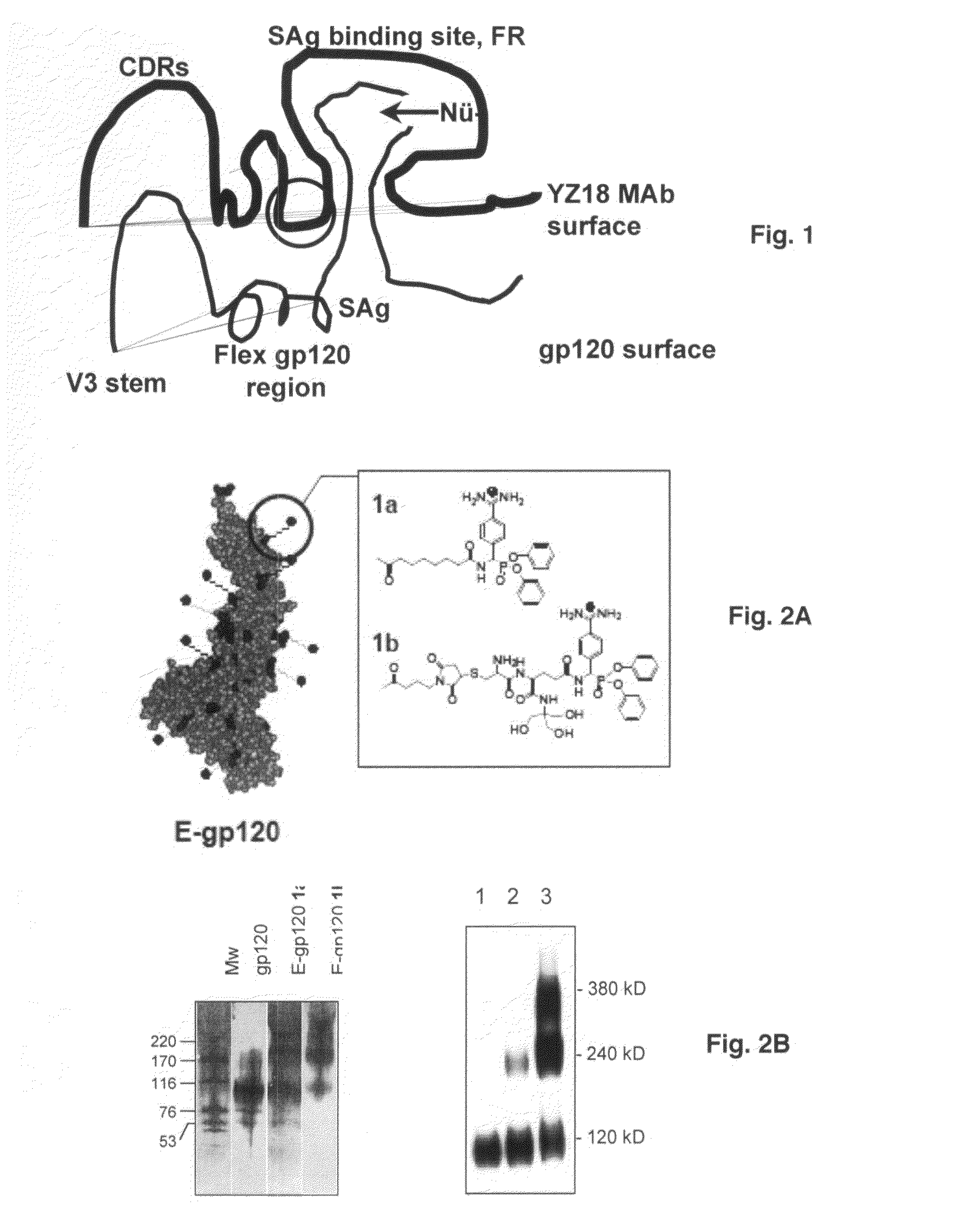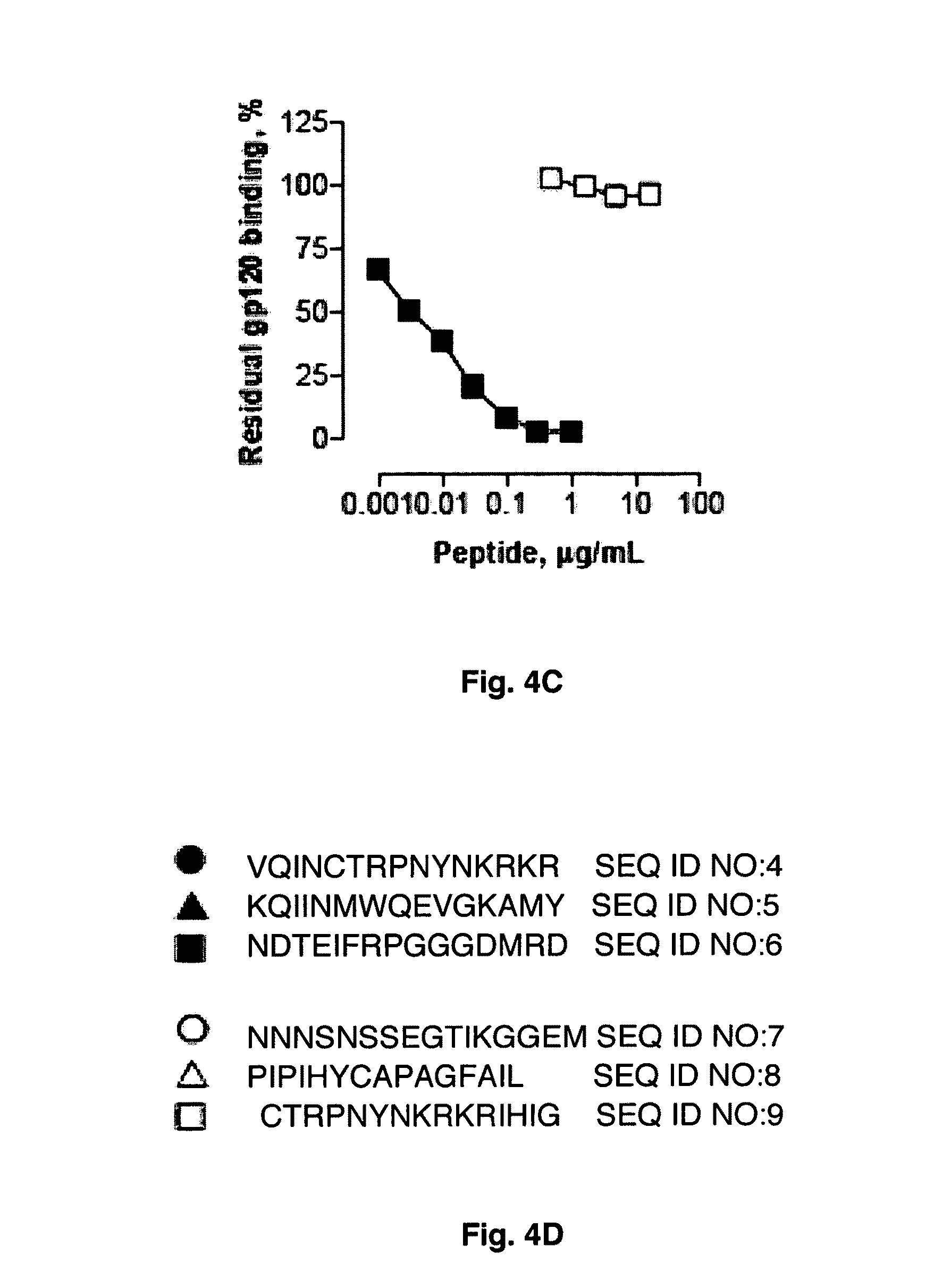Binary epitope antibodies and B cell superantigen immune stimulants
a technology of b cell superantigen and binary epitope, applied in the field of immunology, virology and medicine, can solve the problems of viral escape mutants refractory to neutralization by abs, immune stimulants with only limited defense against superantigen harmful effects, and immune system cannot mount protective adaptive responses, etc., to achieve enhanced nucleophilic reactivity, enhance antibody potency, and hydrolyze antigen
- Summary
- Abstract
- Description
- Claims
- Application Information
AI Technical Summary
Benefits of technology
Problems solved by technology
Method used
Image
Examples
example 5
Isolation of Homogeneous Binary Epitope Specific Antibodies to gp120
[0139]Abs with potent and cross-clade HIV neutralizing activity can be administered to HIV infected patients as passive immunotherapeutic reagents. In addition topical application of the Abs in the vagina or rectum prior to sexual intercourse can be applied to block transmission of HIV. The binary epitope specific Abs described in Example I display the ability to neutralize diverse HIV strains and are prototypical reagents with potential clinical use. The present Example describes the selection and screening of large numbers of Abs using the dual epitope polypeptide analogs of Example II as the means to identify high potency HIV neutralizing Abs.
Source of Abs. In one embodiment of the invention, the Ab source is experimental animals or humans immunized with the polypeptide immunogens described in Examples I and II. These immunogens contain the superantigen (SAg) epitope recognized mainly at the Ab framework regions ...
example 1
REFERENCES FOR EXAMPLE 1
[0143]1. Graham, B. S., McElrath, M. J., Connor, R. I., Schwartz, D. H., Gorse, G. J., Keefer, M. C., Mulligan, M. J., Matthews, T. J., Wolinsky, S. M., Montefiori, D. C., Vermund, S. H., Lambert, J. S., Corey, L., Belshe, R. B., Dolin, R., Wright, P. F., Korber, B. T., Wolff, M. C., and Fast, P. E. (1998) Analysis of intercurrent human immunodeficiency virus type 1 infections in phase I and II trials of candidate AIDS vaccines. AIDS Vaccine Evaluation Group, and the Correlates of HIV Immune Protection Group. J Infect Dis 177, 310-319[0144]2. Pitisuttithum, P., Berman, P. W., Phonrat, B., Suntharasamai, P., Raktham, S., Srisuwanvilai, L. O., Hirunras, K., Kitayaporn, D., Kaewkangwal, J., Migasena, S., Sheppard, H. W., Li, E., Chernow, M., Peterson, M. L., Shibata, R., Heyward, W. L., and Francis, D. P. (2004) Phase I / II study of a candidate vaccine designed against the B and E subtypes of HIV-1. J Acquir Immune Defic Syndr 37, 1160-1165[0145]3. Gorny, M. K., ...
example 2
REFERENCES FOR EXAMPLE 2
[0185]1. Karle, S., Nishiyama, Y., Taguchi, H., Zhou, Y. X., Luo, J., Planque, S., Hanson, C., and Paul, S. (2003) Carrier-dependent specificity of antibodies to a conserved peptide determinant of gp120. Vaccine 21, 1213-1218[0186]2. Graf von Stosch, A., Kinzel, V., Pipkorn, R., and Reed, J. (1995) Investigation of the structural components governing the polarity-dependent refolding of a CD4-binding peptide from gp120. J Mol Biol 250, 507-513[0187]3. Reed, J., and Kinzel, V. (1993) Primary structure elements responsible for the conformational switch in the envelope glycoprotein gp120 from human immunodeficiency virus type 1: LPCR is a motif governing folding. Proc Natl Acad Sci USA 90, 6761-6765[0188]4. Reed, J., and Kinzel, V. (1991) A conformational switch is associated with receptor affinity in peptides derived from the CD4-binding domain of gp120 from HIV I. Biochemistry 30, 4521-4528[0189]5. Kwong, P. D., Wyatt, R., Robinson, J., Sweet, R. W., Sodroski, ...
PUM
| Property | Measurement | Unit |
|---|---|---|
| Length | aaaaa | aaaaa |
| Distance | aaaaa | aaaaa |
| Electrophilic | aaaaa | aaaaa |
Abstract
Description
Claims
Application Information
 Login to View More
Login to View More - R&D
- Intellectual Property
- Life Sciences
- Materials
- Tech Scout
- Unparalleled Data Quality
- Higher Quality Content
- 60% Fewer Hallucinations
Browse by: Latest US Patents, China's latest patents, Technical Efficacy Thesaurus, Application Domain, Technology Topic, Popular Technical Reports.
© 2025 PatSnap. All rights reserved.Legal|Privacy policy|Modern Slavery Act Transparency Statement|Sitemap|About US| Contact US: help@patsnap.com



